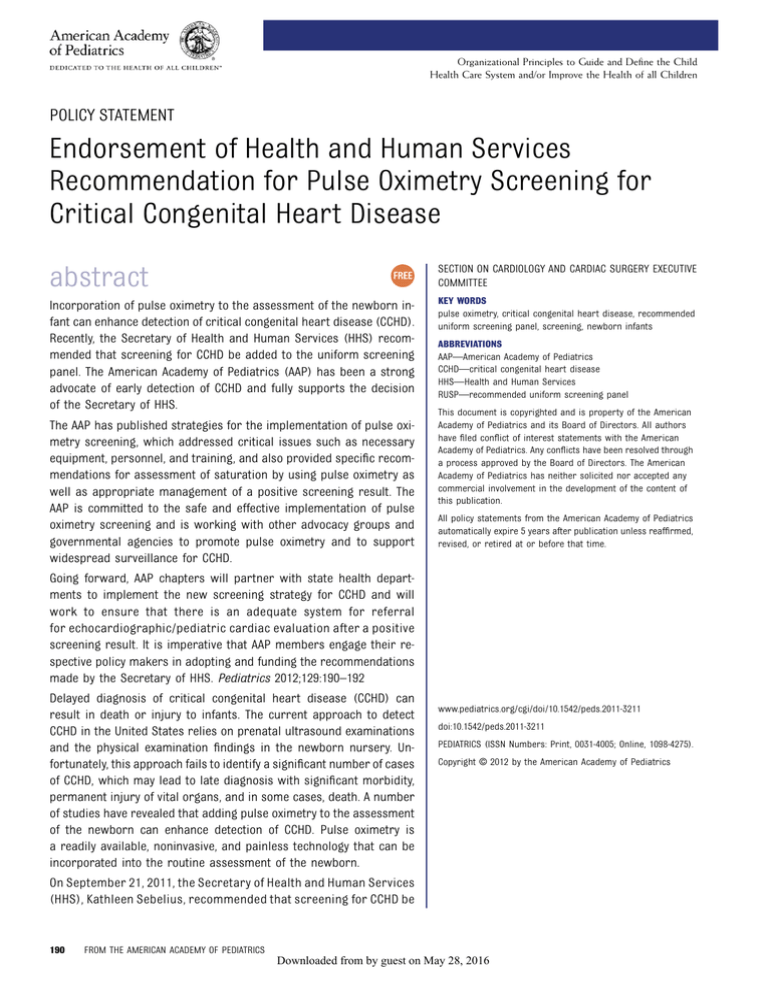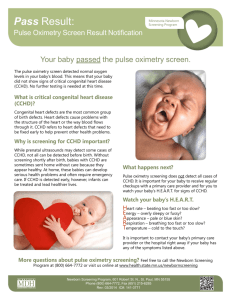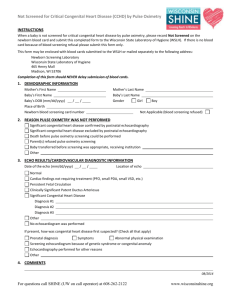
Organizational Principles to Guide and Define the Child
Health Care System and/or Improve the Health of all Children
POLICY STATEMENT
Endorsement of Health and Human Services
Recommendation for Pulse Oximetry Screening for
Critical Congenital Heart Disease
SECTION ON CARDIOLOGY AND CARDIAC SURGERY EXECUTIVE
COMMITTEE
abstract
Incorporation of pulse oximetry to the assessment of the newborn infant can enhance detection of critical congenital heart disease (CCHD).
Recently, the Secretary of Health and Human Services (HHS) recommended that screening for CCHD be added to the uniform screening
panel. The American Academy of Pediatrics (AAP) has been a strong
advocate of early detection of CCHD and fully supports the decision
of the Secretary of HHS.
The AAP has published strategies for the implementation of pulse oximetry screening, which addressed critical issues such as necessary
equipment, personnel, and training, and also provided specific recommendations for assessment of saturation by using pulse oximetry as
well as appropriate management of a positive screening result. The
AAP is committed to the safe and effective implementation of pulse
oximetry screening and is working with other advocacy groups and
governmental agencies to promote pulse oximetry and to support
widespread surveillance for CCHD.
KEY WORDS
pulse oximetry, critical congenital heart disease, recommended
uniform screening panel, screening, newborn infants
ABBREVIATIONS
AAP—American Academy of Pediatrics
CCHD—critical congenital heart disease
HHS—Health and Human Services
RUSP—recommended uniform screening panel
This document is copyrighted and is property of the American
Academy of Pediatrics and its Board of Directors. All authors
have filed conflict of interest statements with the American
Academy of Pediatrics. Any conflicts have been resolved through
a process approved by the Board of Directors. The American
Academy of Pediatrics has neither solicited nor accepted any
commercial involvement in the development of the content of
this publication.
All policy statements from the American Academy of Pediatrics
automatically expire 5 years after publication unless reaffirmed,
revised, or retired at or before that time.
Going forward, AAP chapters will partner with state health departments to implement the new screening strategy for CCHD and will
work to ensure that there is an adequate system for referral
for echocardiographic/pediatric cardiac evaluation after a positive
screening result. It is imperative that AAP members engage their respective policy makers in adopting and funding the recommendations
made by the Secretary of HHS. Pediatrics 2012;129:190–192
Delayed diagnosis of critical congenital heart disease (CCHD) can
result in death or injury to infants. The current approach to detect
CCHD in the United States relies on prenatal ultrasound examinations
and the physical examination findings in the newborn nursery. Unfortunately, this approach fails to identify a significant number of cases
of CCHD, which may lead to late diagnosis with significant morbidity,
permanent injury of vital organs, and in some cases, death. A number
of studies have revealed that adding pulse oximetry to the assessment
of the newborn can enhance detection of CCHD. Pulse oximetry is
a readily available, noninvasive, and painless technology that can be
incorporated into the routine assessment of the newborn.
www.pediatrics.org/cgi/doi/10.1542/peds.2011-3211
doi:10.1542/peds.2011-3211
PEDIATRICS (ISSN Numbers: Print, 0031-4005; Online, 1098-4275).
Copyright © 2012 by the American Academy of Pediatrics
On September 21, 2011, the Secretary of Health and Human Services
(HHS), Kathleen Sebelius, recommended that screening for CCHD be
190
FROM THE AMERICAN ACADEMY OF PEDIATRICS
Downloaded from by guest on May 28, 2016
FROM THE AMERICAN ACADEMY OF PEDIATRICS
added to the recommended uniform
screening panel (RUSP). This recommendation was based in large part
on the Secretary’s Advisory Committee
on Heritable Disorders in Newborns
and Children’s recommendations and
a 2-day comprehensive evidence review of screening strategies by national and international stakeholders.
The American Academy of Pediatrics
(AAP) strongly supports the decision
of the Secretary of HHS to add
screening with pulse oximetry to the
RUSP. The AAP has been a vigorous
advocate of early detection of CCHD to
prevent childhood deaths or injury that
might occur as a result of late detection.
There are a number of important issues
that relate to the implementation of
pulse oximetry into the routine care
of the newborn. A detailed description of
these issues has been published by the
AAP.1 This publication provides a detailed screening algorithm developed
by the Secretary’s Advisory Committee
on Heritable Disorders in Newborns
and Children. It also provides detailed
recommendations regarding necessary equipment, personnel and training, and appropriate management of
a positive screening result. The highlights of screening implementation
are as follows:
The screening is targeted toward
healthy newborn infants in the
newborn nursery.
Screening should be performed
with motion-tolerant pulse oximeters. It is appropriate to use
either disposable or reusable
pulse oximetry probes.
Screening should not be undertaken
until 24 hours of life or as late as
possible if early discharge is planned
to reduce the number of falsepositive results. Separate consideration for home births is necessary.
Oxygen saturations should be
programs, the AAP supports wide-
obtained in the right hand and
one foot. Threshold for a positive
screening result is detailed in the
publication and relates to both
the absolute reading by the pulse
oximeter as well as the difference
between the 2 extremities. Screening that has a pulse oximetry reading of ≥95% in either extremity
with a ≤3% absolute difference between the upper and lower extremity would be considered a pass,
and the screening would end. It is
recommended that repeated measurements be performed in those
cases in which the initial screening
result was positive, again in an effort to reduce false-positive results.
Infants with saturations <90%
should receive immediate evaluation. It is important to note that
the oxygen saturation thresholds
for a positive screening result may
vary at high altitude. Appropriate
studies need to be performed at
high altitude to establish reliable
thresholds.
spread surveillance for CCHD. Such
In the event of a positive screening
result, CCHD needs to be excluded
with a diagnostic echocardiogram.
Infectious and pulmonary causes
of hypoxemia should also be excluded.
The AAP can play an important role
in assuring the safe and effective
implementation of screening for CCHD.
This includes preparing members to
implement
screening;
engaging
pediatricians to participate in qualityimprovement activities to ensure that
newborn infants are appropriately
screened with follow-up echocardiograms and specialty care, as required;
partnering with public health agencies
for surveillance of CCHD; and advocating for appropriate payment for
all screening-related activities. In addition to promoting the implementation of pulse oximetry based screening
PEDIATRICS Volume 129, Number 1, January 2012
Downloaded from by guest on May 28, 2016
surveillance will yield several benefits,
including documentation of any improvement in detection as well as
identification of areas of weakness for
this comprehensive screening strategy.
Although the Secretary of HHS has recommended that screening for CCHD
be added to the RUSP, it will be up to
states to determine how they wish
to incorporate this into their own
screening programs. This may be accomplished by legislation, regulation,
or adoption as a standard of practice.
The majority of disorders identified on
the RUSP are adopted by most states,
but there is variability among the
states. A number of states have already incorporated routine screening
for CCHD into the statewide panel.
These states can serve as a paradigm
for subsequent implementation by
other states.* It will be critical that
AAP chapters work with state health
departments to implement the new
screening strategy for CCHD in
a manner that is adequately financed,
cost-effective, and practical; that
ensures screening and for echocardiographic/pediatric cardiac evaluation and therapeutic intervention as
indicated with provision for follow-up
for all newborn infants within the
framework of the medical home; and
that ensures that related payment
issues for technical and professional
services are addressed. It is hoped
that through these collaborative efforts,
the burden of delayed diagnosis of
congenital heart disease will be reduced and the health of children will be
enhanced for years to come.
*For more information on your state law, please
contact the AAP Division of State Government
Affairs at stgov@aap.org.
191
RECOMMENDATIONS
Pulse oximetry screening for CCHD
should be performed by using
evidence-based guidelines such as
those reported by the Secretary of
HHS Advisory Committee Work
Group, as detailed in the algorithm
in the special article on screening
for congenital heart disease.1
AAP members should encourage
incorporating pulse oximetry
screening into routine newborn
care and the development of effective systems to allow for timely
and accurate diagnostic assessment with echocardiography and
to ensure a medical home for
those found to have CCHD.
AAP chapters, AAP members, and
local advocates should engage their
respective policy makers at the
federal and state legislative and regulatory levels in considering, adopting, funding, and implementing
the recommendations made by the
Secretary of HHS to ensure the
development of the educational
materials; training; equipment,
including echocardiography and
telemedicine needs; system development; and support with access to funding ensured for all
components of medically necessary care.
The AAP will actively engage other
stakeholders and the American
Medical Association to develop
appropriate Current Procedural
Terminology codes for pulse oximetry screening with appropriate
relative value units and should advocate for appropriate payment for
CCHD screening-related activities.
LEAD AUTHORS
William T. Mahle, MD
Gerard R. Martin, MD
Robert H. Beekman, III, MD
W. Robert Morrow, MD
SECTION ON CARDIOLOGY AND
CARDIAC SURGERY EXECUTIVE
COMMITTEE, 2011-2012
W. Robert Morrow, MD, Chairperson
Geoffrey L. Rosenthal, MD, PhD
Christopher S. Snyder, MD
L. LuAnn Minich, MD
Seema Mital, MD
Jeffrey A. Towbin, MD
James S. Tweddell, MD
FORMER SECTION EXECUTIVE
COMMITTEE MEMBERS
Robert H. Beekman, III, MD, Immediate Past
Chairperson
Thomas S. Klitzner, MD, PhD, Past Chairperson
STAFF
Lynn Colegrove, MBA
REFERENCE
1. Kemper AR, Mahle WT, Martin GR, et al.
Strategies for implementing screening for
192
critical congenital heart disease. Pediatrics.
FROM THE AMERICAN ACADEMY OF PEDIATRICS
Downloaded from by guest on May 28, 2016
2011;128(5). Available at: www.pediatrics.
org/cgi/content/full/128/5/e1259
Endorsement of Health and Human Services Recommendation for Pulse
Oximetry Screening for Critical Congenital Heart Disease
SECTION ON CARDIOLOGY AND CARDIAC SURGERY EXECUTIVE
COMMITTEE, William T. Mahle, Gerard R. Martin, Robert H. Beekman III, W.
Robert Morrow, Geoffrey L. Rosenthal, Christopher S. Snyder, L. LuAnn Minich,
Seema Mital, Jeffrey A. Towbin and James S. Tweddell
Pediatrics 2012;129;190; originally published online December 26, 2011;
DOI: 10.1542/peds.2011-3211
Updated Information &
Services
including high resolution figures, can be found at:
/content/129/1/190.full.html
Citations
This article has been cited by 29 HighWire-hosted articles:
/content/129/1/190.full.html#related-urls
Subspecialty Collections
This article, along with others on similar topics, appears in
the following collection(s):
Cardiology
/cgi/collection/cardiology_sub
Permissions & Licensing
Information about reproducing this article in parts (figures,
tables) or in its entirety can be found online at:
/site/misc/Permissions.xhtml
Reprints
Information about ordering reprints can be found online:
/site/misc/reprints.xhtml
PEDIATRICS is the official journal of the American Academy of Pediatrics. A monthly
publication, it has been published continuously since 1948. PEDIATRICS is owned, published,
and trademarked by the American Academy of Pediatrics, 141 Northwest Point Boulevard, Elk
Grove Village, Illinois, 60007. Copyright © 2012 by the American Academy of Pediatrics. All
rights reserved. Print ISSN: 0031-4005. Online ISSN: 1098-4275.
Downloaded from by guest on May 28, 2016
Endorsement of Health and Human Services Recommendation for Pulse
Oximetry Screening for Critical Congenital Heart Disease
SECTION ON CARDIOLOGY AND CARDIAC SURGERY EXECUTIVE
COMMITTEE, William T. Mahle, Gerard R. Martin, Robert H. Beekman III, W.
Robert Morrow, Geoffrey L. Rosenthal, Christopher S. Snyder, L. LuAnn Minich,
Seema Mital, Jeffrey A. Towbin and James S. Tweddell
Pediatrics 2012;129;190; originally published online December 26, 2011;
DOI: 10.1542/peds.2011-3211
The online version of this article, along with updated information and services, is
located on the World Wide Web at:
/content/129/1/190.full.html
PEDIATRICS is the official journal of the American Academy of Pediatrics. A monthly
publication, it has been published continuously since 1948. PEDIATRICS is owned,
published, and trademarked by the American Academy of Pediatrics, 141 Northwest Point
Boulevard, Elk Grove Village, Illinois, 60007. Copyright © 2012 by the American Academy
of Pediatrics. All rights reserved. Print ISSN: 0031-4005. Online ISSN: 1098-4275.
Downloaded from by guest on May 28, 2016



